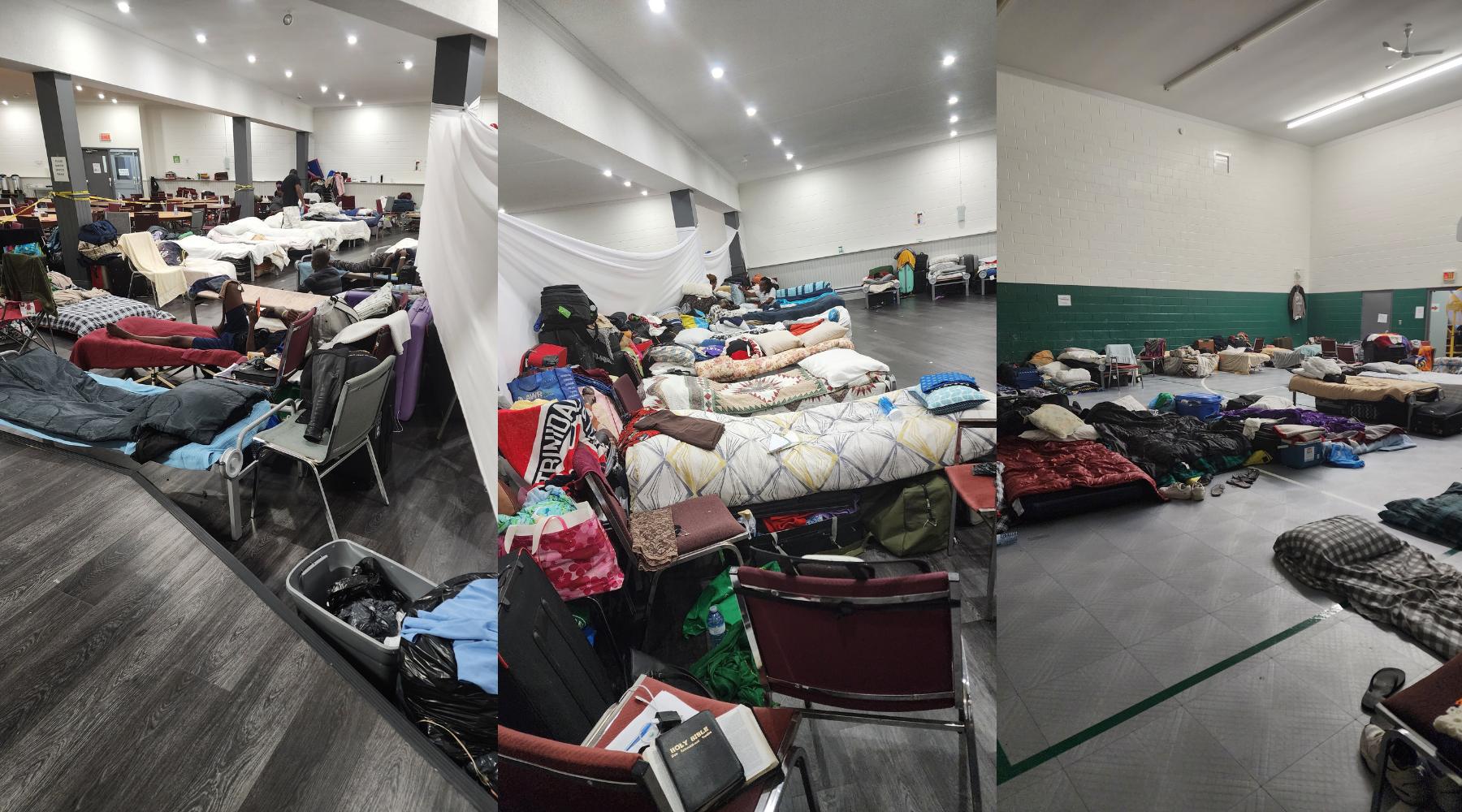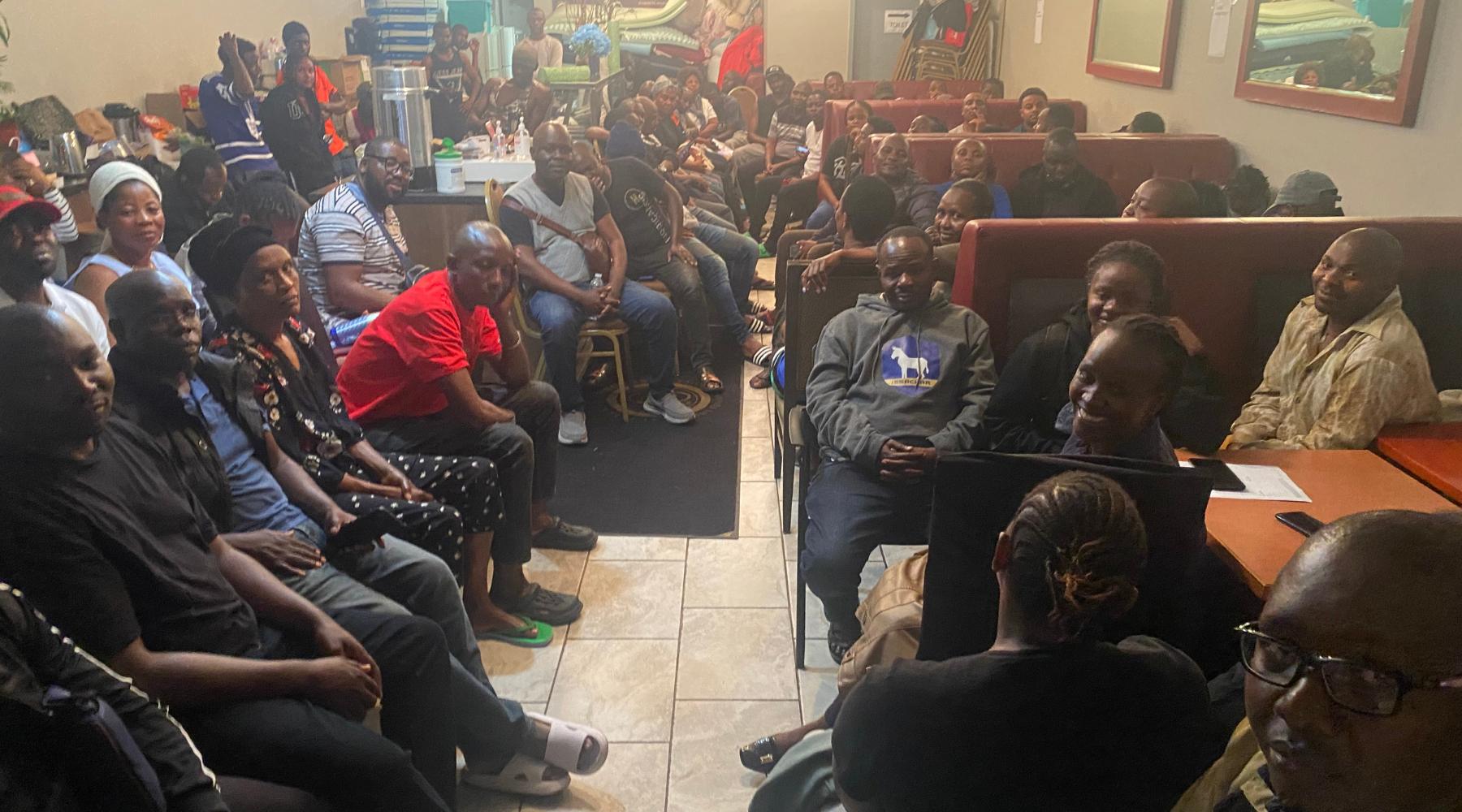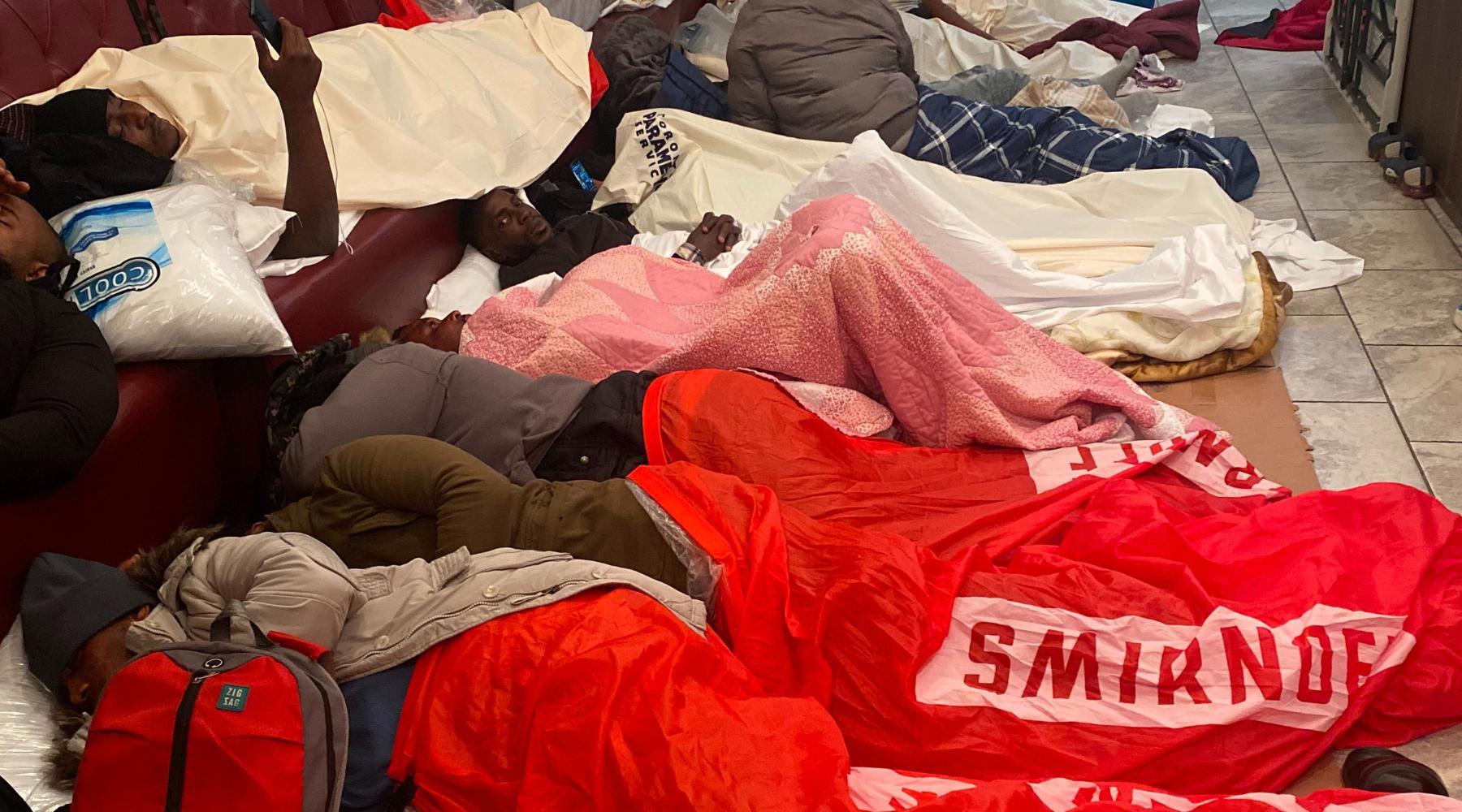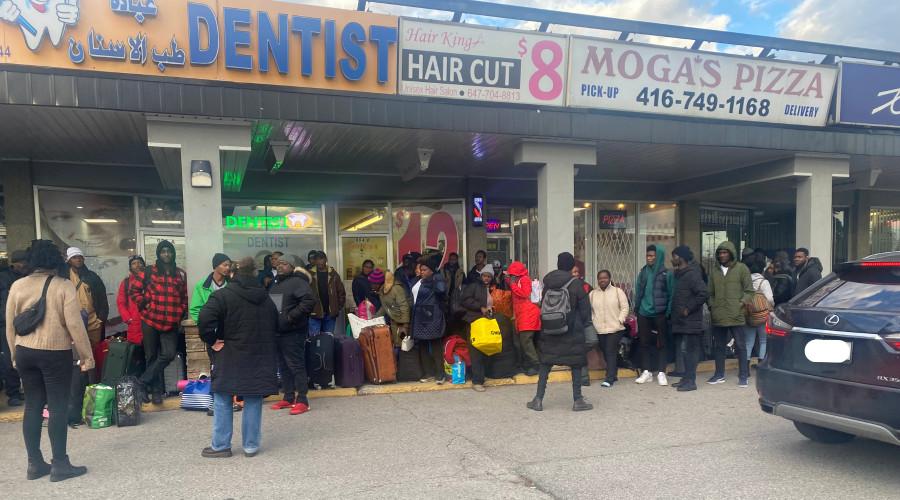Over 50 percent (6,312) are refugee claimants.
An unexpected surge of refugees from African countries began in May 2023, when Toronto’s shelter system was already over capacity with close to 3,000 refugees. The number of asylum seekers in Toronto's shelter system multiplied by more than 500 percent, from a low of about 530 people per night in September 2021 to more than 2,800 in May 2023.
When news broke in July 2023 that a wave of newly arrived refugees from African countries were living on the sidewalk outside a city shelter on Peter Street in Toronto, it could not have come at a worse time. With the number of unhoused people already exploding, the pressure on housing in the greater Toronto area was at a level we had not seen before. This wasn’t just a wave. It was a tsunami. And it crushed whatever was left of the city’s support system.
While the crowd outside this downtown shelter swelled by the dozens under the blistering summer heat, a bureaucratic war of words was raging.
When ByBlacks first reported on this story last July, we spoke to Fatima Yusef, a refugee from Uganda living outside of 129 Peter Street. “We called the city, and when we talked to them they said to call the federal government, but when we call them they tell us to call the city,” she said.
A month earlier, the acting mayor at the time, Deputy Mayor Jennifer McKelvie told the media that Toronto shelters would start turning away refugee claimants and referring them to federally funded shelters. There was just one problem with that: there is no such thing as a federally funded refugee shelter.
It would take months of lobbying before the federal government pledged an unprecedented one-time payment of $97 million to help the city house refugees.
Why Are So Many Refugees Arriving?
Deep poverty, famine, civil war, climate change and discriminatory laws against LGBTQIA+ people sweeping across the continent are some of the major factors leading to an increase in the number of refugee claimants from African countries.
There’s also been a sharp increase in refugee claimants from countries such as Syria, Venezuela, Afghanistan, South Sudan and Myanmar. According to the UN Refugee Agency, Canada received just over 144,000 asylum claims in 2023. It’s a record number, at more than 1.5 times the previous record set in 2022.
Canada is a signatory to the UN Convention on the Rights of Refugees, which means that anyone who claims asylum here is entitled to due process. However, there is a huge difference between the process for conventional refugees and asylum seekers.
Convention refugees are those who are brought to Canada on invitation from the federal government, as was the case with Syrian or Afghan refugees during violent conflict. They can be sponsored by a Canadian citizen or granted permanent residence upon arrival and, therefore, have access to all the same benefits and services as any other permanent resident.
But for refugee claimants (also referred to as asylum seekers), the process is different. It’s a costly, emotionally taxing process that can take months, even years.
Refugee claimants must apply for the right to earn convention refugee status. This status allows the claimant to access social benefits while they await a hearing. Until the government acknowledges their legal claim, they are left without government services, including healthcare.
While the federal government contributes funds to settlement agencies, provinces and municipalities are responsible for housing asylum seekers. However, regional and local governments simply can’t keep up with the demand.
The federal government has actually started deporting asylum seekers at a rapid pace. In 2022 and 2023 alone, Canada deported more than 23,000 undocumented migrants, at a cost of more than $111 million.
If All The Shelters Were Full, Where Did All Of Those Refugees Go?
It was a defining moment for Toronto’s Black community, one where we saw solidarity in action. With the city’s 7,000 shelter beds already full, people rolled up their sleeves and got to work, raising thousands of dollars online to drop off supplies for those waiting for a bed. Local Black businesses donated whatever they had on hand—food, clothing, and toiletries. Prominent Black Canadians like Hon. Jean Augustine and Zanana Akande lent their social capital in the media.
But it was the city’s Black churches that found a way to get all of those people off the streets.
Pastor Judith James from Revivaltime Tabernacle (Founder and CEO of The Beautiful Foundation), Pastor Eddie Jjumba, Senior Pastor Of Milliken Church who coordinates refugee response efforts out of Dominion Church International, and Nadine Miller, director of Pilgrim Feast Tabernacles, were among the first Black churches to step onto the front lines, swinging open their doors even though they could not afford to do so.
It’s been over a year since the height of the crisis, and at least one of those churches is now over a million dollars in debt, and the federal government still doesn’t seem to have a plan in place for the streams of refugees coming in.
In June 2023, Pastor Eddie took three refugees into his own home and called an emergency community meeting, asking his congregation and good willed community members to help. Members of his church and the Ugandan community opened their homes to 25 refugees. He promised the hosts this would just be temporary.
The Pastor was confident he could leverage his past work as a shelter intake worker to find them all spaces in a shelter. But he hadn’t done this kind of work since 2007, “I wasn't prepared for how much things have changed; I could not find available beds anywhere in the GTA.”
Several weeks passed, and his congregation started asking him for help with food and medical expenses. “I realized this wasn’t sustainable, but more community members showed up with food donations. I remember Christopher from African Centre For Refugees came and dropped off 15 bags of rice.”
By mid-July, Pastor Eddie heard that Judith James, a pastor from Revivaltime Tabernacle in North York, was providing shelter to 100 people at her church.
“I had 40 people at Dominion Church and another 60 people still outside Peter Street. So I was hoping they would all get housed at Revivaltime.”
He says the plan was for the bus to go down to Peter Street and pick up the 60 people first and then the other 40 afterwards. But by the time the bus arrived downtown, 170 people were waiting.
He couldn’t just put those 40 people back onto the streets. And that’s how Pastor Eddie’s church turned into a makeshift shelter.
“The first night, we took chairs and put them together, kind of like you would when you’re delayed in an airport.”
The number of people at Dominion International soon grew from 40 to 67 in one day. At one point, 215 people were sleeping in the church, some on the carpeted floor and some on donated mattresses and cots.
The two pastors got to know each other and for the first two months, Pastor Judith supplied all the meals for Pastor Eddie’s group. But it wasn’t long before her church kitchen ran out of supplies.
“Between July and September, we brought in over 1000 people,” says Pastor Judith. “But we served over 4,000 because we were cooking and dropping off food at other locations that could not provide meals.”
During those months, Pastor Judith barely went home. She says she didn’t feel right sleeping in her own bed, knowing the refugees could not, so she slept at the church.

“There were many late nights, staying up and talking about their stories and what brought them here,” says Pastor Judith. She recalls a woman from Uganda who fled political war when her neighbourhood was bombed. Another from Kenya was being threatened because of her sexuality. “She participated in a march for queer rights and the authorities opened fire on the crowd. Her partner was killed right in front of her.”
At Pilgrim Feast Tabernacle, Miller took in so many refugees that she was in constant violation of zoning and fire safety codes. “What could I do? Turn them away?” she asks.
The church was in a plaza in Etobicoke with a few empty office spaces. Miller took those over and ended up with $30,000 monthly rent.

Other expenses, such as food, medication, and transportation, piled up quickly. “When you call an ambulance from the same location 2 or 3 times, the dispatcher will ask you to call an Uber instead because you’re taking up too much of the city’s resources.”
On the day before Thanksgiving, Miller had 350 people sheltered all over the plaza when she got a call asking to help 46 refugees from African countries who had been on the streets. The church was already filled, but Miller phoned a friend at Creekbank Liquidations, and soon, 50 bunk beds arrived.
“We ended up with almost 60 additional people coming in and fed over 450 people that night. What broke my heart was that we had to turn the restaurant into a sleeping area. We had to take cardboard boxes from outside and put them on the restaurant floor. When they were all finally settled, I remember there was just a hush over the room, and it was the best sound I had ever heard. Because I knew they finally had some sense of peace.”

But for Miller, the nights were far from peaceful. Many people arrived needing urgent medical attention, including a pregnant woman with a dangerously high fever from malaria.
“If she had stayed another night on the street, no doubt she and her unborn baby would have died,” says Miller.
By the end of October 2023, Pilgrim Feast Tabernacle was $1.3 million in debt, and Miller was forced to close the church's doors to refugees. “Every week, we got a notice saying we were violating some fire code or another.”
While Miller officially closed the church doors, she didn’t stop taking in refugees. She had a secret room in the plaza that only the refugees knew about, where she continued offering shelter to as many people as possible.
Bending the line of the law seems inevitable in this kind of rescue work. Christopher Nkambwe, founder of the African Centre For Refugees, says she used her own apartment to house 6 refugees but was evicted once the landlord realized what was happening.
Where Are They Now?
Pastor Judith was proactive in helping people find jobs, by teaming up with The Career Foundation to hold a job fair inside the church. “We had Tim Hortons there, the Carpenters Union, Adecco and even the president of George Brown College ensured everyone had information on how to get into courses.”
By August 2023, Pastor Judith was able to encourage federal authorities from Immigration, Refugees and Citizenship Canada (IRCC) to start coming into the church and process the refugees. Pastor Judith says they were picked up by bus and brought to hotels or shelters in places like Niagara Falls, Cornwall and Windsor.
Both Pastor Eddie and Pastor Judith keep in touch with the people they housed via several Whatsapp groups organized by country of origin, including Kenya, Uganda, Nigeria, and Burundi. Many of the refugees are now part of the congregation. Both say many of the refugees are not where they would like to be, but at least are in jobs and have a roof over their heads.
{https://youtu.be/5kkWjSR6uH4}
Pastor Eddie says Dominion International church is financially reeling from housing and feeding hundreds of people.
“I am grateful for groups like the Black Opportunity Fund who simply showed up and looked at the dire situation and donated $20,000 without asking questions.” Pastor Eddie says he was very disappointed that the churches had to ‘beg’ the city to release funds.
Dominion International Church had over $800,000 in eligible expenses, but the City of Toronto was only able to reimburse a little more than 50% of that (costs incurred between July 17th - September 30th, 2023). However, the city has promised to find more funding before the year ends. The United Way stepped in with another $10,000. The Black North Initiative, which was designated to receive funds on behalf of many grassroots Black organizations, provided $100,000. That still leaves Pastor Eddie’s church with over a quarter million dollars in debt.
Nadine Miller from Pilgrim Feast Tabernacle was in a similar situation with a $1.5 million debt load. The City of Toronto reimbursed them $737,222. The United Way provided $10,000, and the Black North Initiative provided $75,000. That means she’s about $170,000 short. And that is only expenses incurred in 2023. The church still continues to house women and children in Air BnBs and hotels, incurring hundreds of thousands more in costs.
The Beautiful Foundation incurred more than $400,000 in expenses while housing refugees at Revivaltime Tabernacle. The charity received $336,421 from the City of Toronto and $10,000 from The United Way in reimbursement. They are still calculating the costs needed for renovations, as the church building endured significant wear and tear while sheltering hundreds of refugees.
All three leaders say they have no regrets about spending money out of pocket to help the hundreds of people who came through their doors. They are laser-focused on making sure this does not happen again. Miller says she is still constantly fielding calls from social service agencies or people in the neighbourhood, like a UPS delivery driver who once spotted two refugees sleeping behind a plaza.
What Happens Now?
“We need 5 to 8 acres of land, with a welcome centre and transitional housing,” says Pastor Judith. “Unless our community works together, acquires land and puts in the necessary infrastructure, we will continue to have this crisis. Let’s be honest with ourselves: a group of Black people were left outside for months at a time and blocked out of systems. If we as a people don’t recognize this is part of the systemic racism at play, and start to work together effectively, we will still be here next year.”
In November 2023, a refugee from Nigeria died outside of a Mississauga shelter, while waiting for a bed space. Three months later, another refugee died outside of the same shelter while waiting in the cold for a space. She was a mother of four.
After more than six months of political wrangling behind the scenes, the federal government now says it will assist with upfront funding for the refugee welcome centre. In an email response to ByBlacks, a representative from Immigration, Refugees and Citizenship Canada said, “IRCC has raised its initial pledge ($7 million reimbursement) and will be supporting this initiative with a $22 million upfront payment, under the Interim Housing Assistance Program (IHAP), toward the 2024 costs of establishing and launching the project. This upfront payment is currently being processed.” IRCC also says it expects the reception centre to begin operations in the “coming months.”
However, a representative for the Region of Peel says they are still in negotiation with the federal and provincial government. They declined to share the proposal for the welcome centre or divulge the entire cost of the project. But in an email to ByBlacks said, “Peel has been clear that the reception centre will only open if it is fully funded by the federal and provincial governments.”
The representative says not only does it need full funding for the welcome centre which would offer temporary housing, legal and medical help, but it also needs funding for “... up to 3 dorm‐style shelters dedicated to asylum claimants in Peel (separate from local homeless shelters) that would support 1300 asylum claimants monthly.”
$22 million seems like a drop in the bucket for such an ambitious project, and it appears the feds and the region are at a stalemate. The federal government is boasting about the amount of money it is showering on Peel region, while the region is saying it won’t budge until the federal and provincial governments cover the entire cost and continue to fund it annually.
While politicians drag their feet and shake their fists at each other from the comfort of their homes, refugees continue to arrive and line the sidewalks in pockets all over the GTA. Winter is coming, and people are worried we will see more tragedy on the streets.
“You know, a white brother asked me this question,” says Pastor Eddie. “They said if all those refugees sleeping on your church floor and on the street had been white people, how long do you think it would have taken the government to act?”
It’s been over a year, and the community is still waiting for long-term solutions.

 By
By 





